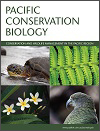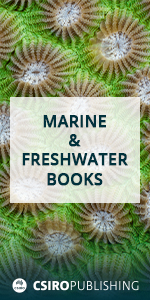Pacific Conservation Biology
Volume 31
Number 5 2025
During a bushfire recovery project involving the deployment and monitoring of nest boxes on Kangaroo Island, we discovered that the poorly known Endangered Kangaroo Island dunnart was partially arboreal and used, and possibly built, nests of finely shredded wood in pygmy-possum nest boxes.
Wildlife tourism holds promise for conservation, yet insights are limited in the non-Western context. We critically review existing Japanese wildlife tourism research, identifying gaps and future directions. Twenty-eight articles analysed revealed the need for multidisciplinary approaches emphasising animal ethics. This review highlighted the importance of integrating ecological and cultural considerations.
Cleaning symbiosis is most often reported from tropical coral reefs. We show that this mutualistic relationship occurs between female Coris auricularis (Labridae) and a range of resident and transitory fish species on temperate artificial reefs. The vertical relief and fish aggregation effect allow artificial reefs to act as cleaning stations.
The green turtle (Chelonia mydas) is the only sea turtle to reside year-round in New Zealand. This pilot study used drones to visually confirm a temperate neritic green turtle foraging ground in northern New Zealand. Estuaries and coastal New Zealand ecosystems are under increasing human pressure, highlighting the need to identify and protect these important habitats.
Predation shapes the survival of vulnerable species such as the flatback turtle. At Cape Domett, Australia, we found that saltwater crocodiles frequently prey on nesting turtles and hatchlings, with approximately one adult killed weekly. These findings highlight increasing ecological pressures on turtle populations, urging the employment of enhanced conservation strategies.
Feral cats persist year-round in the Australian high country and exploit habitats above the winter snowline. Cats use built structures more intensively in winter but are also active on and under snow. Continuing management is needed around ski resort buildings and infrastructure to reduce potential cat-impacts on threatened species.
Historically, humpback whales migrating past Aotearoa New Zealand (NZ) were linked to western South Pacific wintering grounds and Antarctic summer feeding grounds. To determine the recovering population’s connectivity to South Pacific wintering grounds, we generated DNA profiles of whales from 1998 to 2021. Humpback whales passing mainland NZ on their north and southbound migrations are strongly associated with East Australia and New Caledonia. Those migrating south past Rangitāhua have a broader range of wintering grounds, including a connection to Central America.
We introduce Nature Quotient (NQ), a new form of intelligence focused on understanding and managing human-nature interactions. Individuals and societies can better adapt to environmental challenges, promoting sustainable and conservation behaviors, and fostering a culture that prioritizes ecological health and resilience in the face of biodiversity loss and climate change by enhancing NQ.





